THE INSPIRING HEROES BATTLING THE HIDDEN POACHING EPIDEMIC
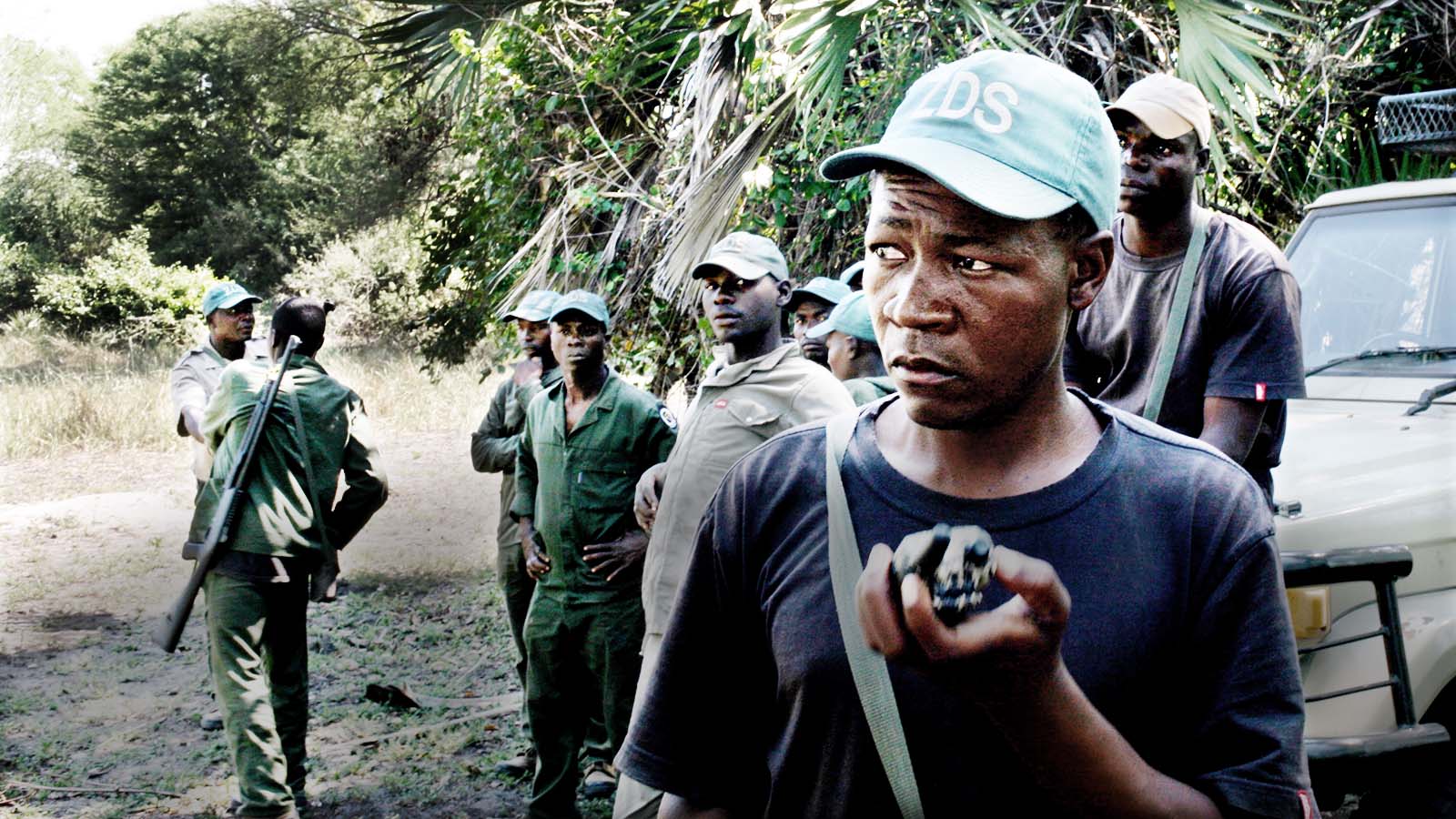
Members of the ZDS anti-poaching squad test out radios after receiving training from American military veteran Nick Wackym.
Members of an antipoaching squad employed by a private hunting concession in a wildlife reserve in Mozambique, November 2015. (Photo: Laura Krantz)
Once upon a time, in a pristine forest with an abundance of wildlife, the people of a small village had plenty of food. They grew cassava, a staple starch, and supplemented that by fishing from the river and hunting in the surrounding forests. Then, one year, traders from distant logging towns arrived and offered the villagers money and goods in exchange for meat. The villagers agreed. For the next five or 10 years, they filled the traders’ canoes with the bounty of the forest and sent them back down the river, to the logging towns and to cities where the men took the meat to market. At first, hunters could still go out in the morning and come back by nightfall with food for the village, or at least enough for their families, along with something for the traders. After a while, though, the takings grew more sparse. Soon they could walk for three days and come back with nothing, every time. For 15 miles in any direction from that village, there were no animals. No mammals, no birds, no reptiles. “We didn’t think we could kill all our wildlife,” a village elder told Heather Eves, who wrote about what happened for her 2006 Ph.D. dissertation in forestry and environmental studies at Yale. “If we had known we could kill all our wildlife in such a short time, we would never have sold it to the traders.”
>What happened in this remote part of the Republic of the Congo is so routine it might as well be a parable. For centuries, people across Africa have hunted wildlife, mainly for food and a portion for trade. Such harvesting was relatively sustainable. But in recent decades, a number of factors, including considerable population growth; growth of extractive industries such as mining and logging, which opened access to the forested interior; development of transportation routes; and migration to cities have led to unsustainable levels of illegal wildlife poaching and trade.
When we think of poaching, we almost always think of elephants and rhinos. Horns lopped off the heads of rhinos and tusks carved from the mutilated faces of elephants evoke feelings of horror and sadness. Bushmeat poaching is a more insidious, quieter form of poaching. It usually doesn’t make front-page news or lend itself to such shocking photos. Many of the big stories on bushmeat show up during some sort of epidemic; epidemiologists strongly suspect that infectious diseases such as Ebola and HIV jumped to human populations through the hunting and eating of bushmeat. Every year, people smuggle thousands of pounds of bushmeat into the U.S. and Europe—primate parts, antelope, cane rats, bats—which has dangerous ramifications. But there’s less awareness of the incredibly destructive effect bushmeat hunting has on African wildlife, from warthogs to baboons to birds to antelope and, yes, even elephants.
Untold numbers of critters die painful deaths in filthy, rusted metal jaws with two-inch jagged teeth called gin traps, which clamp shut on the leg of the animal that steps in one. Or they perish in snares—crudely fashioned wire nooses that wrap around the neck or a leg, causing the animal to die slowly of strangulation or starvation. Perhaps the cruelest fact of bushmeat poaching is that 90 percent of animals caught in snares and gin traps are never collected by the people who set them. Instead they rot away for no purpose whatsoever.
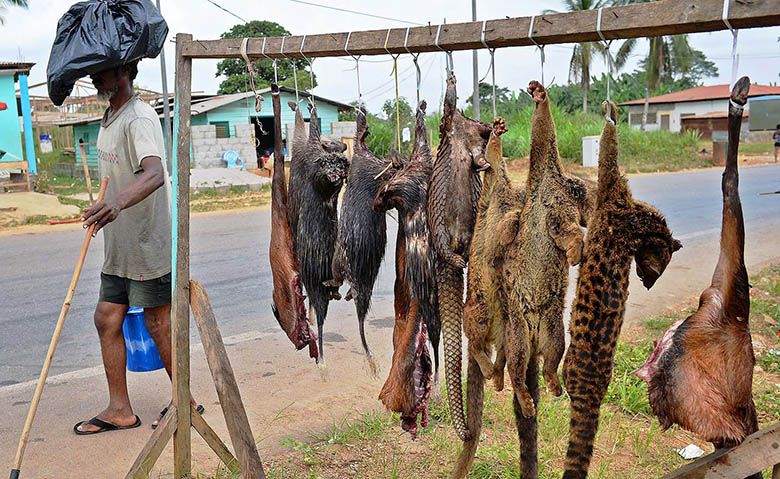 Serval, endangered pangolin, and other bushmeat is displayed for sale along a roadside outside Bata, Equatorial Guinea, in 2015. (Photo: Carl de Souza/AFP/Getty Images)
Serval, endangered pangolin, and other bushmeat is displayed for sale along a roadside outside Bata, Equatorial Guinea, in 2015. (Photo: Carl de Souza/AFP/Getty Images)
Even with its murderous inefficiency, the bushmeat trade surpasses the value of the illegal ivory trade. In Tanzania, authorities confiscate more than 2,000 tons of bushmeat annually—worth about $50 million. That’s piddling compared with the Central African nations—49,000 tons in Gabon, 59,000 in the Central African Republic, 189,000 tons in the Republic of the Congo, according to a 2012 report from the nonprofit group Panthera. That paper reports 182,000 to 365,000 tons of illegally harvested wildlife meat in Mozambique, with a commercial value of between $366 million and $730 million a year. For comparison, the U.N. Office on Drugs and Crime estimates that in 2011, thirty-seven tons of illicit ivory, worth around $30 million, made its way to Asia, home to about two-thirds of the global ivory market.
“I’ve seen poachers who set up snares and traps within three to five kilometers of their base camp and wipe out everything,” says Craig Windt, a 21-year-old South African who leads an antipoaching squad in central Mozambique. Rory Young, an antipoaching strategist and coauthor of A Field Manual for Anti-Poaching Activities, has had similar experiences. “You’ll go into an area, and you look for anything alive, and you can’t find any living thing,” he explains. “No birds, no small animals, not any tracks of any animals in the area, because they’ve killed everything. They even burn the grass to catch the mice.” The trees’ days, too, may be numbered, as the loss of wildlife means no animals are around to disperse seeds or otherwise fulfill their role in the forest ecosystem.
Some countries—South Africa, Kenya, Namibia, Botswana—are taking important new steps to end the poaching of big-ticket items such as elephants and rhinos. In February, a bipartisan U.S. congressional delegation paid a visit to several African countries to show support for the work their governments are doing to save these iconic wildlife. “Iconic” is the key word here. The not-so-iconic species didn’t receive much attention. Bushmeat poaching just isn’t a priority for most African governments, which is why much of the work to stem it falls to NGOs and the private sector. Efforts are piecemeal, however, and still developing.

Members of the antipoaching squad follow two poachers they’ve apprehended to the place where the men had set animal traps. At right is a U.S. military veteran who has volunteered to assist with training for the squad. The gun is for protection against animals they may encounter. (Photo: Laura Krantz)
Even a handful of American military veterans have joined the cause.
At 6:30 a.m. on what’s shaping up to be a brutally hot day in November 2015, retired U.S. Air Force Lt. Col. Nick Wackym, 57, meets turquoise-eyed Craig Windt and his antipoaching patrol. Wackym, a fireplug of a man with a graying Captain Morgan goatee, is here for a week, training Windt’s team of 17 locals in various skills, such as how to better use radios and perimeter alarms and administer wilderness first aid. “I’m here to help these guys get a little more ahead of the poachers, build them some more breathing room,” Wackym says. For the early hour, both he and Windt are remarkably chipper. “We’ve got a lead on a local,” Windt says. “My guys heard about him in the village. They know where he lives; we’ve caught him before.”
Windt slams a cup of coffee and strides out to his truck, a severely battered Toyota Land Cruiser. His squad patrols a government-designated wildlife utilization area, known as Coutada 11, in central Mozambique. The men, wearing heavy olive drab uniforms with long sleeves and long pants, pile into the bed of the Land Cruiser. Old-fashioned metal canteens swing from some of their shoulders. Two sling rifles over their backs, not to stop poachers but to take out any wounded, charging animal they might encounter.
South African native Craig Windt and Mozambican members of the antipoaching squad he leads get ready to start their daily patrol. (Photo: Laura Krantz)
Coutada 11’s 2.5 million acres of sand forests, floodplains, and swamps, located in Mozambique’s Zambezi River delta, crawl with all kinds of animals, from baboons and tiny suni antelope to water buffalo and zebras. The picturesque region, however, wasn’t always so abundant with wildlife. From 1975 to 1992, Mozambique fought a civil war that decimated the wildlife population as it destroyed infrastructure, littered the country with land mines, gutted the economy, and left a million dead and 5 million displaced. Starving citizens turned to wildlife for survival. Troops on both sides used bushmeat to feed their soldiers. Legally protected areas—national parks, game reserves, forest reserves—went unprotected.
After the war, a tall, rangy South African with a loud laugh and a bawdy sense of humor named Mark Haldane saw the potential to revive the myriad species that had once lived in the delta and opened Zambeze Delta Safaris, a hunting concession, in Coutada 11. “When we started in 1994,” he recalls, “there were only about 1,200 buffalo on the delta. Now it’s closer to 22,000. We only knew of 44 sable. Now there are about 3,000. Virtually every type of game has come back.” Rebuilding those populations required vision, major financial investment, and tremendous patience. When Haldane entered the picture at the end of the war, he wasn’t sure the risk would pay off. His success is because of an active antipoaching strategy—the team he and Windt assembled going out twice a day, every day, to keep poachers from setting up camps, laying traps, and getting entrenched. When Wackym heard about ZDS’ work, he offered up his services free of charge. An alphabet soup of military acronyms liberally seasons his sentences, and every story seems to begin with some variation on “Back in Afghanistan….” He’s impressed with what he’s seen so far: “This group is already way ahead for this continent on antipoaching.”
“In the old days, before we had these guys, it wasn’t unusual to have 20 guys poaching in a group,” says Haldane. “They’d come into an area and stay there until there wasn’t any game left.” They’d set up snare lines, cutting gaps in the bush to encourage animals to move in a certain direction, and catch critters by the hundreds. But at least in Coutada 11, those days are pretty much over, thanks to Haldane’s efforts to deter poaching while maintaining good relationships with the villages. “If someone tries to set a snare line, we’ll find out about it,” he says. “Someone will go have a beer in the evening in the village, talk about putting up a snare line. Someone else will hear about it and pass that information along to the antipoaching guys.”
That’s what happened the night before this patrol, when a local told one of Windt’s rangers about the poaching operation another villager was running. As the punishing sun climbs higher in the sky, Windt’s Land Cruiser bumps wildly along the washboard road, slowing for overhead branches so none of the men standing in the back gets brained by a tree. One shouts at Windt to stop. He points to tracks by the side of the road—a bicycle, which poachers frequently use. “It’s as hot as it is now, and these guys will pedal 60 kilometers to the nearest town carrying 200 pounds of meat on their bikes,” says Windt, a tinge of awe in his voice.
He parks the truck in a patch of sparse, useless shade and issues quick orders, dividing his men into two groups that will come at the poacher’s village from different directions. They bushwhack through the scrubby palm understory to reach a collection of small thatched huts and a lone half-dead tree in the center of a dusty clearing. Scraggly chickens scatter at the uniformed men’s appearance. A handful of women with small children stare at the ground, avoiding eye contact, as the team asks questions that receive monosyllabic responses. Then a ranger yells sharply from a thicket of palms.
Behind their suspect’s house, he has found the evidence they’re looking for: a mud-daubed furnace, for soldering together discarded car parts into gin traps, attached to a bicycle-wheel contraption that uses a pedal and gears to drive a bellows. Behind another clump of palms, they find a few animal parts strewn about—warthog feet, shrunken skins—and several drying racks, where poachers hang meat before transporting it to the market down the road.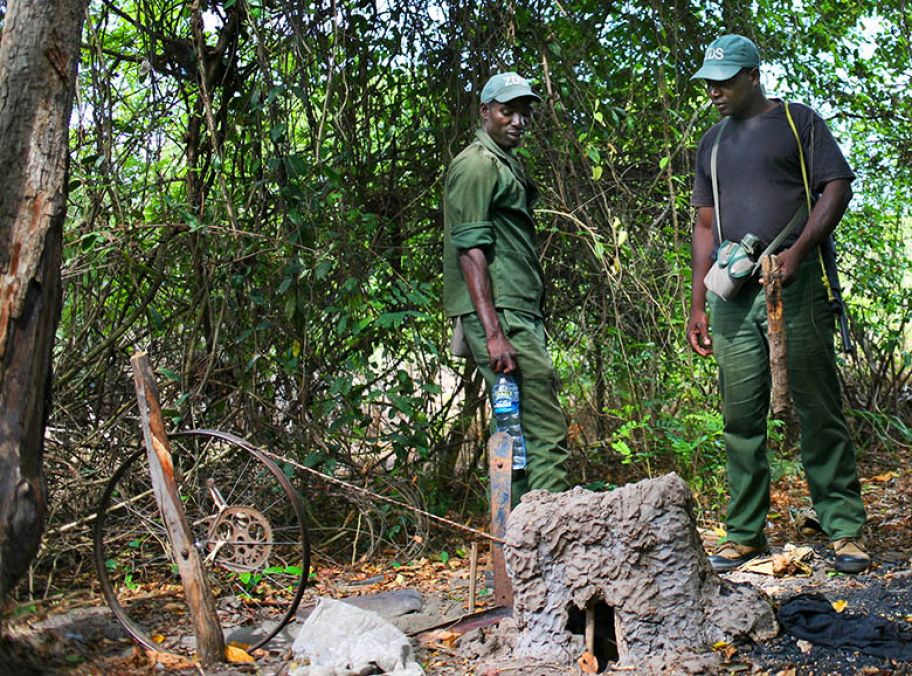
Two members of the antipoaching team eye a mud-daubed furnace and a bicycle-wheel bellows built by a local poacher to forge animal traps. (Photo: Laura Krantz)
Windt’s men drive their boots through the handmade furnace and dismantle the drying racks. They gather up the bicycle bellows and every last scrap of metal, hauling it all back to the truck to use as evidence. Everyone is amped. At the truck, they hop in and take off, ready to chase this guy down, make an arrest. Before they’ve made it a mile, one of the men yells for Windt to hit the brakes. On the path parallel to the road, walking casually along, is their suspect, sporting a bright yellow shirt and spouting all kinds of denials. He’s accompanied by a solemn-faced young man who turns out to be his accomplice. The rangers pull out a couple of gin traps and the bicycle wheel, offering them a chance to turn themselves in with no trouble. The two abandon whatever plans they might have had and climb into the back of the truck.
It’s all very peaceful—no bullets, no blood, no shouting, no chase scene. The rangers slap handcuffs on them, both cuffs on the same wrist like bangles, a sign of how little concern they have about their captives bolting. “They won’t try to run,” says Windt, “because they know they’ll get a hiding.” Yellow Shirt is a local guy. The rangers chat with him, shake his hand. He’s someone’s neighbor; his wife socializes with the rangers’ wives. The team can’t afford to be too aggressive with locals, Windt says. The rangers live in the villages, have relationships with the people there, get information from them—like the lead they got last night. Smacking local poachers around for no good reason won’t make the squad’s job any easier.
A few more questions and the poachers spill where they’ve planted a couple of gin traps, out on the river’s parched floodplain. A 20-minute drive brings the team to the edge of the plain; the yellow-shirted poacher climbs out, barefoot, and leads the squad to a shallow two-foot-long trench where he points out the familiar oblong shape of a gin trap. A ranger disarms it with a thick stick and orders the poacher to carry it back; he hefts it up onto his shoulder and returns to the truck.
Bushmeat poaching overwhelmingly is carried out by locals like Yellow Shirt and his accomplice. Many are just looking for an available source of protein. “People have forgotten in the West what it means to lack protein,” says Rory Young. Additionally, illegal hunting is a way to make some money. Local poachers who catch more than they can eat will sell hundreds of pounds of dried and smoked meat to nearby towns, where protein is in high demand, and often to big cities. “What’s been playing out across landscapes is a rural to urban movement,” says Eves, the former director of the Bushmeat Crisis Task Force in Washington, D.C. “When we move, we bring our food traditions with us. And even when we move to places where there are other sources of protein available, where getting bushmeat is so much more expensive, people will pay the price to have food from home.”
Yellow Shirt is only the first step in a long chain of bushmeat poaching. He sells his goods to a guy, who sells it to another trader. By the time the meat gets to a city, it’s been sold three to four times. Similar to rhino horn or ivory, bushmeat reaches the market through established entrepreneurial supply chains. The people moving these goods—often from Africa to Asia—number in the hundreds, if not thousands. They’re not all full-time bad guys. Some are bureaucrats and businessmen and shippers who are on the payroll; many are locals, looking to supplement meager incomes. They really don’t care about the nature of the contraband. Cigarettes, weapons, drugs, ivory, meat—it doesn’t matter. All that matters is that this is a market with low costs and high rewards. There’s a lot of money moving along that chain and a lot of people who stand to benefit. Stopping it, says Eves, requires people like Haldane’s antipoaching group in Mozambique, who have relationships with communities and act as a deterrent. Especially when it comes to bushmeat, there also have to be alternative sources of protein and other ways for people to make money. For any strategy to really be successful, the demand for bushmeat in urban centers must be curtailed.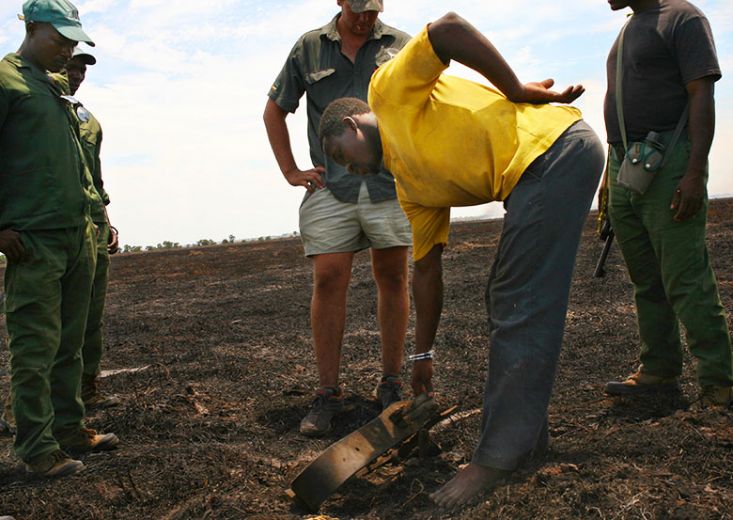
A bushmeat poacher in the custody of the antipoaching squad picks up a trap he had set. (Photo: Laura Krantz)
“What I found in Central Africa is that in communities where there were alternative forms of income—ways to make money, to buy retail goods—and there was enforcement on what could be hunted, how it could be hunted—gun hunting, no snares—people tended to hunt at a fairly limited level,” says Eves. “They ate what they killed, but the meat stayed local. In places where there was no chance at a job, no income-earning opportunities, and also no enforcement—those folks were hunting way more wildlife and shipping off way more to commercial traders.”
In short, not all bushmeat hunting is bad. Wildlife hunting that sustains healthy genetic diversity and supports reproduction levels while meeting demand can be sustainable. “People who are hunting because they’re hungry—I understand that,” says Eves. “That’s important. And I never want to see local people vilified for their practices and their traditions.” But even sustenance hunting can be unsustainable if the demand is high enough. “If the demand on wildlife is greater than its ability to reproduce, at some point in time, you are going to have a problem.”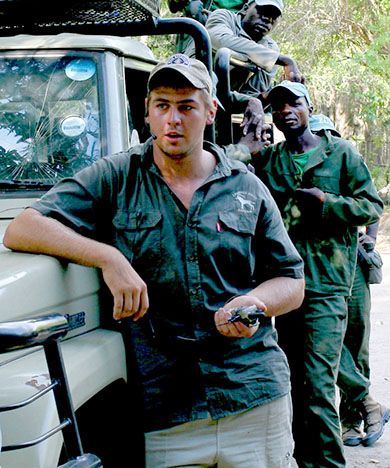
Dialing down the commercial poaching rampant across Africa into a sustainable practice requires a system that will provide locals with alternative forms of protein, as well as other opportunities for earning income. It also means putting resources into deterring bushmeat poaching and enforcing the laws when they’re broken. All of these are threads in Haldane’s strategy for Coutada 11. Money comes in from rich foreigners who pay premium prices for permits to hunt here. Those funds go to building and staffing a school, digging water wells, and providing a portable mill to grind maize for villagers, along with maintaining hunting camps and critical infrastructure used by both foreigners and locals. Plans for a health center are in the works, and half the meat from the hunts goes to villages, which means everyone has plenty to eat.
Haldane’s success has led to considerable growth: He now employs, by his count, 58 local people full-time. “Which means we’re supporting a lot of other people” he points out, “when you add up all the kids and in-laws.” That discourages locals from poaching and creates a largely positive relationship between the villages and the hunting camp. But Haldane is a victim of his own success: While his antipoaching team has been able to keep poaching at low levels for at least a decade, the increasingly abundant wildlife populations mean more poachers are coming in from outside areas. “There are two kinds of poachers here,” explains Haldane. “Subsistence—that’s the majority of the time. These are people looking for a bit of extra meat or catching the warthogs rooting around in their gardens. They have a right to do that, and the units don’t patrol in the gardens. But then there are the commercial meat poachers; many of those are guys who are coming in from the outside.” Africa’s explosive development also contributes to the problem: A sugar mill in the next coutada over employs 12,000 people, many of whom are looking for meat. They either poach it themselves or buy it from someone like Yellow Shirt. As logging and mining extends into the African interior, places once far from civilization become easier to reach. More roads means more job opportunities, which means more human settlements, most of which are poorly planned and bring too many people to places with too few resources, leading to more bushmeat hunting. Timber and mining companies have even been known to encourage workers to forage for bushmeat because it’s cheaper than bringing in food from the outside.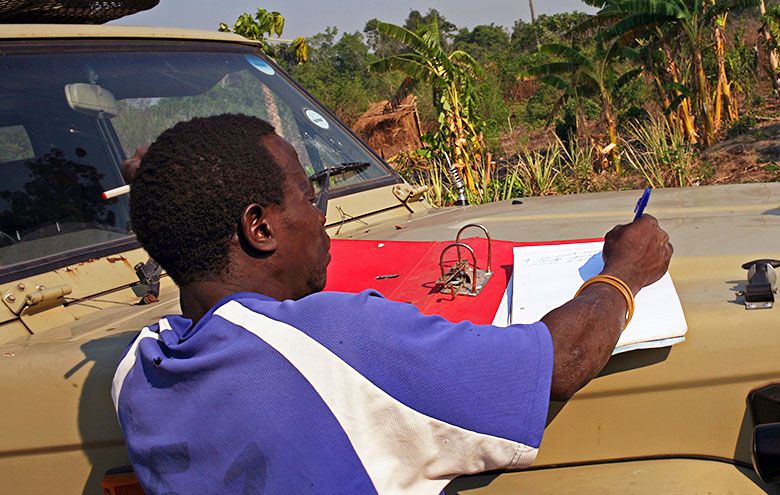
The local official charged with sentencing poachers records the names and offenses of the two men caught by the antipoaching squad. (Photo: Laura Krantz)
Last year, the antipoaching team caught 127 poachers and found 1,227 snares and 104 traps. But while Coutada 11’s antipoaching squad is keeping bushmeat hunting in check, it is hampered by one big hurdle—the law. The legal system of Mozambique barely registers poaching as a misdemeanor, to be dealt with at the most local level. Justice for Yellow Shirt and his pal will be served not in a courtroom but on the hood of Windt’s Land Cruiser, which he has parked near a thatched-hut village, two days later. A crowd gathers to watch the morning’s proceedings—a more interesting event than hacking away at the pineapple and cassava plants in their weathered gardens.
The arrival of a short man in a blue-and-white athletic shirt causes the crowd to part. He carries a red three-ring binder, which he flips open on the hood of the truck. He has authority from the national court system to deal with lower-level crimes like poaching. He listens wordlessly to what the rangers have to say and examines the evidence they’ve brought: gin traps, snares, the remains of the gin-trap furnace. The poachers come forward, speaking softly as the official transcribes their names and their transgressions in the binder. With no pomp or ceremony, no decrees or lectures, he hands down the sentences: 20 days of labor in Coutada 11, helping maintain roads and camps. They’ll get a place to sleep and three square meals a day, and after 20 days, they’ll be free to go home. It’s the same punishment Yellow Shirt received the last time he was picked up, and as Windt points out, it’ll be the same next time too.
Wackym watches the proceedings from a few yards away. He keeps a straight face but clearly finds the sentences too light. “The risks for these guys are low,” he says, speaking of the poachers. “They catch these guys over and over again—the rate of recidivism is too high.”
In a country with a per-capita GDP of just over $600, animal welfare doesn’t rate very high. Just about every type of instability—from times of severe weather or drought to economic and political upheaval—drives bushmeat poaching. Zimbabwe, dealing with political strife and economic crisis off and on for decades, has seen a surge of illegal hunting. A wave of refugees from war-torn Burundi has fostered an increase in illegal hunting in Tanzania. The rule seems to be that the worse the problem, the more people rely on hunting to make ends meet.
Poachers have killed half of Mozambique’s elephants in the last five years, according to the U.S.-based Wildlife Conservation Society, with little to no repercussions. If killing an elephant doesn’t make many waves, you can imagine how little attention is being paid to the poaching of warthogs and antelope. As of December of last year, the country has much bigger fish to fry. After more than 20 years of peace, the Renamo rebel movement and Mozambique’s government are leaning dangerously close to war. According to the United Nations High Commissioner for Refugees, close to 12,000 Mozambicans have fled to neighboring Malawi to escape clashes between the two forces. War doesn’t just claim human lives; it causes a significant increase in poaching.
In February, the guerrilla movement that fought the government in Mozambique’s civil war launched ambushes in Sofala province, where Mark Haldane’s hunting concession is. He says he’s not too worried yet. “I don’t think it affects our bushmeat trade,” he says. “But if you go to where these chaps are setting up ambushes, they’re probably resorting to poaching to feed themselves.” If the conflict escalates and expands, much of his work in this area could be undone.
Research for this story was supported in part by a grant from the Fund for Investigative Journalism.







Follow Us!